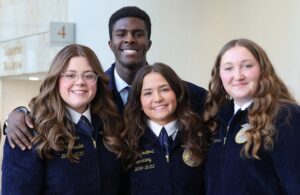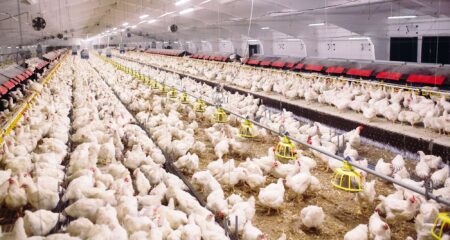USDA Secretary Brooke Rollins unveiled her policy aimed at addressing rural veterinarian shortages this week.
“In many rural areas, there simply aren’t enough food animal veterinarians, leaving livestock without timely access to preventive care and vulnerable to dangerous diseases that can wipe out herds and flocks,” wrote David Schmitt, former Iowa state veterinarian, in an Iowa State University College of Veterinary Medicine blog post.
Rollins’ op-ed column published below highlights the challenges faced by food animal veterinarians, particularly in rural areas, and briefly describes solutions that USDA will pursue. The department shared a more detailed policy plan to help fill veterinary positions in rural areas and the federal government in a 6-page Rural Veterinary Action Plan provided to Successful Farming on Monday.
At the beginning of the document Rollins said the “inability to fill veterinary positions in rural areas and the Federal government is alarming and threatens our supply chain.”
This USDA map contains all the shortage situation designations of the 2025 fiscal year cycle.
Here’s a synopsis of the elements of the announcement.
Challenge: Veterinary Grant Programs are Oversubscribed
The Veterinary Medicine Loan Repayment Program (VMLRP) is a grant that helps veterinarians who commit to serving certain high-priority veterinary shortage areas offset a portion of their student loan debt.
“If you commit to at least three years to providing veterinary services in a designated veterinary shortage area, NIFA may repay up to $40,000 of your student loan debt per year,” the website explains.
In fiscal year 2024, 170 people applied for VMLRP. However, with current funding, USDA is only able to make about 65 awards.
USDA Solution: USDA is making an additional $15 million available to fund VMLRP.
“The funding will come from previous funding provided by Congress to improve food and agricultural supply chain resiliency,” a USDA spokesperson said.
Challenge: Applications for Grant Programs are Burdensome
The Veterinary Services Grant Program (VSGP) is designed to relieve veterinarian shortage citations and support veterinary services and come in two forms.
First, Education, Extension, and Training grants under this program help develop, implement, and sustain veterinary services through education, training, recruitment, placement, and retention of veterinarians. Second, Rural Practice Enhancement grants help establish or expand veterinary practices in rural areas.
Policy documents noted the application processes for these VSGP and VMLRP are burdensome.
USDA Solution: The VSGP website explained, “To expedite distribution of Fiscal Year 2025 NIFA grant funds for the VSGP, some processes for this FY have changed. This program will not issue an RFA in FY25. Funds will be distributed to existing projects or previously peer-reviewed and meritorious but unfunded proposals. NIFA will issue an RFA in FY26 upon receipt of appropriations.”
When USDA issues the Request for Applications (RFA) for VMLRP in December that covers both FY2025 and FY2026 funding, there will be a streamlined application process that requires less information and can be submitted via an online portal rather than email. Additionally, USDA is considering streamlining the annual reporting requirements for veterinarians once they receive a VMLRP or VSGP award.
Challenge: More Information is Needed to Understand Rural Veterinary Shortages
USDA National Institute of Food and Agriculture releases a map of veterinary shortage situations each year that are used to determine grant eligibility. Nominations from State Animal
Health Officials and Federal Animal Health Officials are used to identify shortage situations.
The policy document says, “Because these veterinary shortage situations are based on nominations from these officials, they do not fully reflect the lack of veterinarians in rural areas across the country. These veterinary shortage situations are usually designated once the existing veterinarian has either moved away or retired and do not forecast where potential shortages may be in the next couple of years.”
USDA Solution: The USDA Economic Research Service (ERS) will study the issue of rural veterinary shortages and produce a report to be used by policymakers seeking to address this crisis.
The study will take six months to complete with in-house staff already employed by the ERS. A start date has yet to be determined, said a USDA spokesperson.
Challenge: Recruiting and Retaining USDA Veterinarians
The policy document explains this problem has been building for more than a decade. “ Rural posts, port inspections, and export certification roles are particularly hard to staff, especially when the pay offered by private practices in urban and suburban areas is more competitive than government pay,” USDA said.
USDA Solution: The department is looking to make federal service more attractive for veterinarians. This includes:
- USDA will explore pay increases and career advancement opportunities for federal veterinarians. This may include establishing special pay rates for veterinarians.
- Revitalizing existing internship and scholarship programs. Policy documents name three programs that will include up to $20,000 tuition reimbursement for undergraduates and up to $40,000 per person per year for graduate scholars starting in 2026.
- USDA will explore a recruitment bonus for federal veterinarians.
- USDA seeks external partnerships with universities, local communities, farmers, and youth organizations to recruit the next generation of rural veterinarians.
Challenge: Starting a Veterinary Practice is Expensive
Starting a veterinary clinic in a rural area often takes a significant investment in facilities and equipment. Coupled with the student debt many recent graduates face, this can discourage folks from practicing in rural or large animal situations.
USDA Solution: The USDA Rural Development Mission area has several programs designed to help rural small business owners by providing financial assistance, technical support, and resources to help them expand, become more competitive, and promote community development.
“To better educate veterinary schools and recent veterinary school graduates about programs available to help finance clinics, USDA will catalog relevant USDA programs, including Rural Development programs such as the Business & Industry Loan Guarantees and the Community Facilities Program,” the policy document said.
Challenge: Understanding Barriers to Entry
Only 20% of first-year veterinary students come from rural backgrounds with a similar
percentage expressing interest in rural practice, according to data from the American Association of Veterinary Medical Colleges.
Estimates from the American Veterinary Medical Association show that 72.9% of veterinary school graduates in 2024 entered into companion animal practice while 3.3% went into production animal practice, 5.9% into equine practice, and 9.6% into mixed animal practice.
USDA Solution: USDA will hold listening sessions between now and October 1, 2025 to hear from key stakeholders including the vet schools to determine what additional actions can be taken to reverse these trends and recruit food animal veterinarians to USDA and rural areas.
Rollins Op-Ed: “USDA is Working to Correct the Rural Veterinarian Shortage”
by Brooke L. Rollins, U.S. Secretary of Agriculture
Putting farmers first means taking a close look at the entire agricultural industry. Behind the safest, most abundant, and most affordable food supply in the world are not only farmers and ranchers but also the veterinarians who keep American livestock and poultry healthy and protect our food safety.
Food animal veterinarians are the guardians of our food supply and perform crucial work such as preventing and responding to animal disease outbreaks including bird flu and the New World Screwworm and inspecting meat and poultry for human consumption. Yet fewer and fewer veterinarians are choosing to work in this lifesaving industry.
Estimates indicate that only 3 to 4% of new veterinary graduates enter food animal medicine and less than 3% enter public practice roles such as those at USDA. This is due to many factors, including the field’s high debt-to-income ratio and low starting salaries.
As a result, rural America is facing a serious shortage of veterinarians, and patterns indicate that it will only get worse unless we take serious steps to reverse it. In 1985, roughly 40% of veterinarians were focused on food animals. Today, that number is about 5%. Older food animal veterinarians are retiring without anyone to take up the mantle.
That’s why I launched the USDA Rural Veterinary Action Plan—a bold strategy to recruit more veterinarians into rural America and into existing public service opportunities at USDA.
First, USDA is enhancing and streamlining our existing grant programs for rural veterinarians. We are expanding the reach of our Veterinary Medicine Loan Repayment Program (VMLRP) to encourage more practitioners to serve in rural America and stay there. And we are investing $15 million in this program, which helps to offset the educational loans of veterinarians in exchange for their work in rural shortage situations.
USDA’s Economic Research Service is also issuing a report that will give us a clearer picture of the rural veterinarian shortage and help us make informed policy decisions to alleviate the problem today.
Next, we are working to recruit and retain more veterinarians into critical public service roles at USDA by bolstering existing veterinary student scholarship programs.
To promote awareness among veterinary students and veterinarians of the tools available to support them, we are cataloging the resources available through USDA Rural Development to rural veterinarians seeking to finance their practices. The significant educational debt most veterinarians incur makes it particularly challenging to start or run a business in a rural area, and by creating this catalog we are working to ease this burden.
At Mississippi State University, I was proud to announce this bold plan alongside U.S. Senator Cindy-Hyde Smith. MSU and the State of Mississippi are taking their own steps to tackle these challenges. Last year, MSU’s College of Veterinary Medicine opened its Center for Rural Veterinary Practice, which works to equip vet students and vets for the unique challenges of rural practice, and the state of Mississippi established a scholarship program for MSU vet students who commit to practicing in rural Mississippi for a minimum of four years following graduation. Under President Trump, we at USDA applaud leaders around the country who realize local problems need local solutions.
Veterinary shortages are a serious problem for rural America, and we are taking serious steps to reverse the trend. Under the Trump-Vance Administration, we are doing everything we can to support rural Americans and protect American consumers. These bold actions will help protect our food supply and promote rural prosperity and result in better outcomes for producers and for everyday Americans nationwide.


:max_bytes(150000):strip_icc()/IMG_1591-2048x1365-362687ca596f4814967abffff2b4be2c.jpg)
:max_bytes(150000):strip_icc()/SuccessfulFarmingShareImage-8fed6410b43147a19ed5ea1e3243227f.png)



:max_bytes(150000):strip_icc()/Win-McNamee-GettyImages-2207027204-9a28aea436244bc2bbeb0a2b912c3be8.jpg)

:max_bytes(150000):strip_icc()/IMG_7575-ac6db3006a2145109bcc2df421c7a962.jpeg)

:max_bytes(150000):strip_icc()/Markets-3-Corn-up-3-19bdbeee0041452db8bce0a0f1c8b883.jpeg)